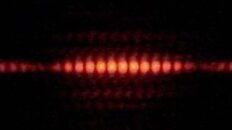Chemical rockets have made it possible for us to launch satellites into orbit and land humans on the moon, but if we want to go further, into the solar system and beyond, we’ll need a different kind of engine, and NASA has recently partnered with DARPA to build a new nuclear thermal propulsion engine named DRACO. If successful, it could change the trajectory of our future in space.
TRANSCRIPT:
In 1942, the United States military was testing a top secret plane at the Muroc Dry Lake Bed in California, the current site of Edwards Air Force Base.
The plane was called the P59, and it was the first US jet engine plane. The secrecy around this thing was insane, almost the same level as the Manhattan project.
In fact whenever they moved this plane around the base, they put a fake propellor on the front. Because all planes before this were prop planes, and a plane with no propellor would obviously get people’s attention.
But of course they couldn’t disguise it when it was in the air, so test pilot Jack Willems decided to take things to a bit more… advanced level.
He went to a costume shop in LA and bought a gorilla suit, a Derby hat and a big fake cigar. And he would wear this costume whenever he was flying the plane.
And he did this so that later when the pilots told people what they saw, nobody would believe them.
In fact, they would get sent to the base psychologists who were in on it and used it to convince them they were crazy.
(act out) So you’re saying you saw a plane with no propellor, being flown by a gorilla, smoking a cigar. You can hear yourself right now, yes?
They basically gaslit an entire base full of pilots to believe that they didn’t see what they actually saw.
It’s kind-of a brilliant bit of psychology when you think about it.
And they did this for good reason. Jet engines would go on to totally change military aviation in the 40s and 50s, and then passenger aviation in the 50s and 60s.
It’s kinda hard to overstate how much jet engines changed the world. Air travel literally quadrupled in the 10 years after the first passenger jets left the runways, for the first time, the average person could travel over the air.
Jet planes were faster to their destination, but it was really the economics of jet engines that made them win out.
Jet engines ran much smoother than piston engines, so they lasted longer, needed less maintenance, also ran on cheaper fuel than piston engines.
They were the technological leap that changed the world for air travel. And now, we may be seeing the same thing happening for space travel. Let’s talk about it.
Back in January of this year, NASA, the National Aeronautics and Space Administration, announced they were teaming up with DARPA, the Defense Advanced Research Projects Agency, on a program called DRACO, which stands for Demonstration Rocket for Agile Cislunar Operations.
Yeah, there’s gonna be some acronyms up in here.
NASA Administrator Bill Nelson summed the program up this way: “NASA will work with our long-term partner, DARPA, to develop and demonstrate advanced nuclear thermal propulsion technology as soon as 2027. With the help of this new technology, astronauts could journey to and from deep space faster than ever – a major capability to prepare for crewed missions to Mars.”
The part of the announcement that makes space nerds all tingly is “nuclear thermal propulsion.” At long last, NASA’s building a nuclear rocket.
And the timeline is ambitious, if not ridiculous.
Because not only are they wanting to get an entirely new type of engine up and flying in 5 years, DRACO will include a rocket, a spacecraft, and a launch vehicle. All by the end of September 2027.
Good luck. With that.
The spacecraft has a name, and of course it’s an acronym. The eXperimental Nuclear Thermal Rocket Vehicle, or X-NTRV.
Swing and a miss on that one.
These nuclear engines will be powered by a type of fuel called High Assay Low Enriched Uranium, or HALEU.
I never know how to pronounce that.
The Low Enriched Uranium part isn’t anything special. It’s what nuclear power plants typically use in reactors. It’s the High Assay bit that sets it apart.
Assay is basically the concentration of fissile isotope, so a higher assay means more bang for the buck.
HALEU fuel has an assay between 5 and 20 percent of fuel mass. That’s a much lower assay than the 90 percent plus used in nuclear weapons, but higher than the assay of uranium used in power plants.
I actually talked about HALEU in a previous video about uses for nuclear waste, there are some experimental reactors that can make this out of nuclear waste and make energy with it.
Nuclear vs Chemical Fuel
Okay, so why is this a step up from the chemical rockets we use today? Well for one thing, it doesn’t need an oxidizer like chemical rockets do.
Stepping back, just in case there are any rocket noobs out there, rocket fuel needs oxygen to burn, just like everything on planet Earth. The problem is, that rocket… leaves Earth. That’s kind-of the point.
So rockets have to bring the oxygen with them in the form of liquid oxygen. So when you see these fuel tanks like on the SLS, only half of that is actual rocket fuel. The other half is oxidizer.
This not only adds a lot of weight, it cuts down on the amount of time the engine can burn because it’s literally emptying two tanks at once.
But a nuclear rocket doesn’t need oxidizer because it’s not actually burning the fuel. It’s just using nuclear fission to superheat it and expand it, flinging it out the back, which provides thrust.
Without all that oxidizer, nuclear rockets save a ton of weight. Actually, many tons of weight.
Most nuclear rocket designs use hydrogen as the fuel of choice because of its low atomic weight. There are some downsides to this though.
Because yes, nuclear rockets save mass on oxidizer, but past designs have needed three times the amount of hydrogen to generate the same thrust. It’s too early to say if that will be the case with DRACO.
But to get back into the plus column, nuclear rockets have a very high specific impulse, which means they are super efficient.
Specific impulse measures how efficiently an engine converts fuel to thrust. It’s often measured in seconds, as in how many seconds it can create thrust in Earth gravity.
And according to an article from the US Office of Nuclear Energy in December 2021, the “the initial target for a nuclear powered rocket” would be twice as efficient as a chemical rocket.
For example, the Space Shuttle had a specific impulse of just over 450 seconds, meaning it could accelerate its own mass in Earth’s gravity for seven-and-a-half minutes. An engine powered by a nuclear rocket would be more like 15 minutes.
And the longer you accelerate, the faster you can go, that’s the idea behind ion drives.
And just like ion drives, we won’t be using these engines to actually get off the ground, they’re just for once we’re in space. You can kind-of think of these as ion drives on steroids.
But ultimately what that translates to is we can go super fast across vast distances. There’s a reason why they’re starting to take this seriously at the same time that we’re making plans to send people to Mars.
The Nuclear Advantage
A one-way trip to Mars using modern chemical rockets would take about seven months. A nuclear rocket like the Office of Nuclear Energy had in mind could make the same trip in as little as 100 days.
And at least one new design at NASA could do even better. Just weeks before the DRACO announcement, an engine designed by Ryan Gosse at the University of Florida claimed to get specific impulses as high as 4000 seconds. With very little added mass.
That’s more.
A spacecraft powered by Gosse’s engine could reach Mars in…are you ready for this…45 days.
That’s less.
Getting to Mars faster isn’t like trying to beat your best time to visit your cousin out in west Texas, reducing flight time is EVERYTHING when it comes to Mars.
Every extra day an astronaut spends on the trip to Mars is another day of being exposed to higher than normal radiation levels and cosmic rays, and it’s another day that they’re losing muscle and bone density.
Not to mention it’s an extra day of food and provisions for everyone on board, all of which takes up space and adds weight.
Nuclear Rocket History
So, this might be the point where you’re saying to yourself, if nuclear rockets are so great, why aren’t they already in flight? There’s actually quite a history.
Back in the 1950s, the United States began working on a program called NERVA. Which stands for Nuclear Engine for Rocket Vehicle Application. And that, kids is how you acronym.
The military had been working on atomic propelled aircraft because of course they were, the world was trying to power everything with atomic energy back then, it was the ATOMIC AGE!
But they gave up on the planes out of concerns about the radiation. So they moved on to nuclear rockets.
I did a video a while back about NASA’s original post-Apollo plans, drawn up by the Space Task Group that Richard Nixon created. Which by the way, if you haven’t seen that, it’s worth a watch, some of the plans they drew up for the 70s and 80s were just bonkers in hindsight and a lot of it relied on this NERVA engine.
Also, fans of the Apple TV series For All Mankind, the NERVA engine is what was on their version of the Space Shuttle, which they called Pathfinder.
But anyway, in 73 when Nixon was president, the Apollo program was winding down and a lot of programs got cut, and the NERVA engine was one of those programs.
In a bit of a double whammy, the Soviets were working on their own nuclear rocket at the time and when the Americans cut their program, they kinda just… let their slide as well. It really was just a giant pissing contest.
Environmental Concerns <
Probably the biggest thing holding back nuclear propulsion is the environmental question. We are, after all, talking about putting nuclear reactors on top of massive controlled explosions.
To be fair, the NERVA testing facility had an excellent safety record. And space programs have been launching nuclear material since 1961, usually in the form of radioisotope thermoelectric generators, or RTGs.
These provide power for satellites and space probes, especially if they’re going into deep space where solar energy is harder to come by.
Between 1961 and 2006, the US successfully flew 41 RTGs to space. Including the New Horizons spacecraft in 2006, the Curiosity rover in 2011, and in 2020 with Perseverance.
They haven’t all gone perfectly though.
In 1964, a US launch failed, resulting in a small amount of Plutonium-238 being released in the atmosphere. Pu-238 is not great for humans, especially their skeletons and livers.
Which, according to wikipedia, are important.
A large section of Russia was showered with polonium in 1969. In 1978, the loss of the USSR’s Kosmos 954 satellite caused uranium to rain down on a 600-kilometre swathe of Canadian soil.
The Canadian government charged Russia $6 million for the clean-up, and eventually collected half as much.
Point is, we’ve been launching nuclear material for a long time. Yes, there have been a few issues, but nothing bad enough to ban them.
Also rocket safety has come a long way since the 60s and 70s.
So I, for the record, am excited by this. I really think that if we’re going to get serious about Mars, if we want to get serious about going “beyond” as NASA keeps saying with the Artemis program, we’ve got to get serious about nuclear propulsion.
Beyond DRACO to Nuclear Pulse <
But if we really want to go “beyond,” there’s something beyond nuclear thermal propulsion. And that’s nuclear pulsed propulsion.
Sounds similar. But very different.
Nuclear pulsed propulsion is basically pushing a spacecraft forward by setting off nuclear explosions. Over and over and over again.
That’s the “pulse.”
The shock wave from the explosions impact a pusher plate and the spacecraft moves. As you can imagine, you can get some high specific impulse and speed from straight-up nuclear bomb going boom.
How high? Well the US actually developed something like this, they called it Project Orion, and it was expected to achieve 6000 seconds on the low end, to 100,000 seconds at the high end.
Four hundred and fifty.
Even more bat guano crazy was Project Daedalus, which was proposed by the British Interplanetary Society.
It proposed speeds equal to 1/2th the speed of light. But this would require fusion power. It was a bit more of a thought experiment.
Just to be fair though, if we ever want to get serious about interstellar travel, we will need exactly something like this.
But if we were to ever attempt something like Project Orion, we would need to re-evaluate our international nuclear treaties.
The Partial Test Ban Treaty of 1963 was one reason Project Orion was abandoned. Kinda hard to test that rocket without setting off some nuclear explosions.
But hey, DRACO seems to be a great first step. I do think their timelines are a bit ambitious, but I look forward to seeing what they come up with.
I want to see something like the Pathfinder from For All Mankind. That was badass.




Add comment